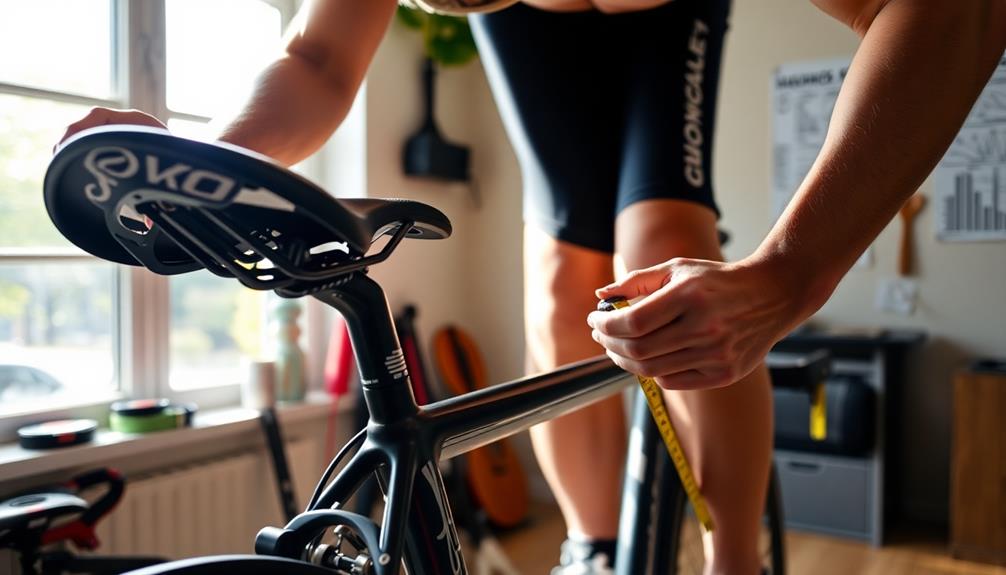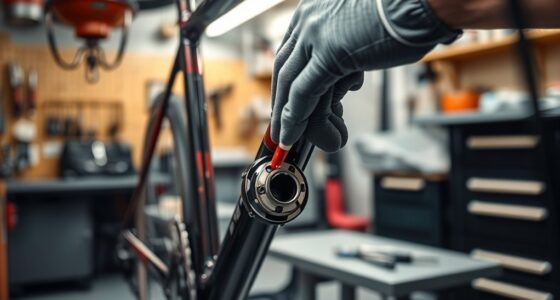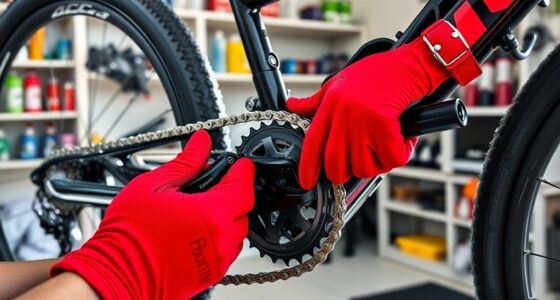To keep your bike running smoothly and last longer, wipe it down after every ride to remove dirt and sweat. Check tire pressure, inspect quick-release levers, and tighten bolts regularly. Lubricate the chain and moving parts to prevent rust, and store your bike in a dry place. Always do a quick safety check before riding. Keep up with these daily care steps, and you’ll discover simple ways to extend your bike’s lifespan.
Key Takeaways
- Perform post-ride cleaning and inspection to prevent rust and identify damage early.
- Check tire pressure and hardware, ensuring proper inflation and tightness for safety and durability.
- Regularly lubricate moving parts like chains and derailleurs to reduce wear and corrosion.
- Store the bike in a dry, secure environment and protect it from elements and theft.
- Conduct a quick pre-ride safety check, including brakes, wheels, and bolt tightness, for optimal performance.
Wipe Down and Clean Your Bike After Every Ride
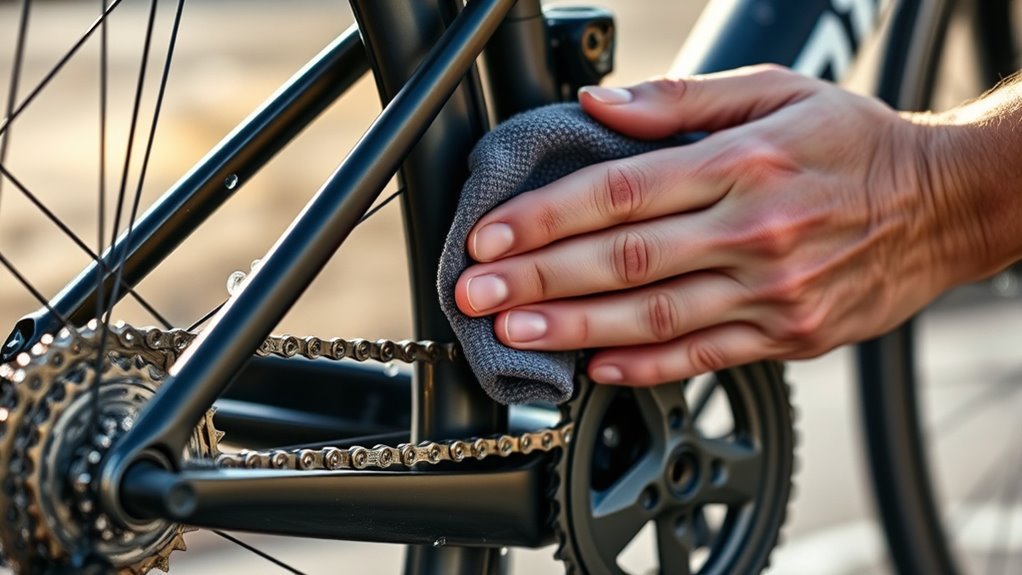
After each ride, it’s important to wipe down and clean your bike to keep it in top condition. Start by wiping the frame, handlebars, and saddle with a clean, damp cloth to remove dirt and sweat. Use a soft brush or sponge to gently clean the drivetrain, including the chain, cassette, and chainrings, to prevent grime buildup that can cause rust. Dry the bike thoroughly with a microfiber cloth or towel to avoid moisture that leads to rust and corrosion, especially on metal parts. Regular cleaning helps maintain smooth operation and extends your bike’s lifespan. After cleaning, don’t forget to inspect for any signs of damage or loose bolts so you can address issues early. A clean bike rides better and lasts longer. Incorporating proper maintenance techniques can further enhance your bike’s durability and performance over time.
Check and Adjust Tire Pressure Regularly
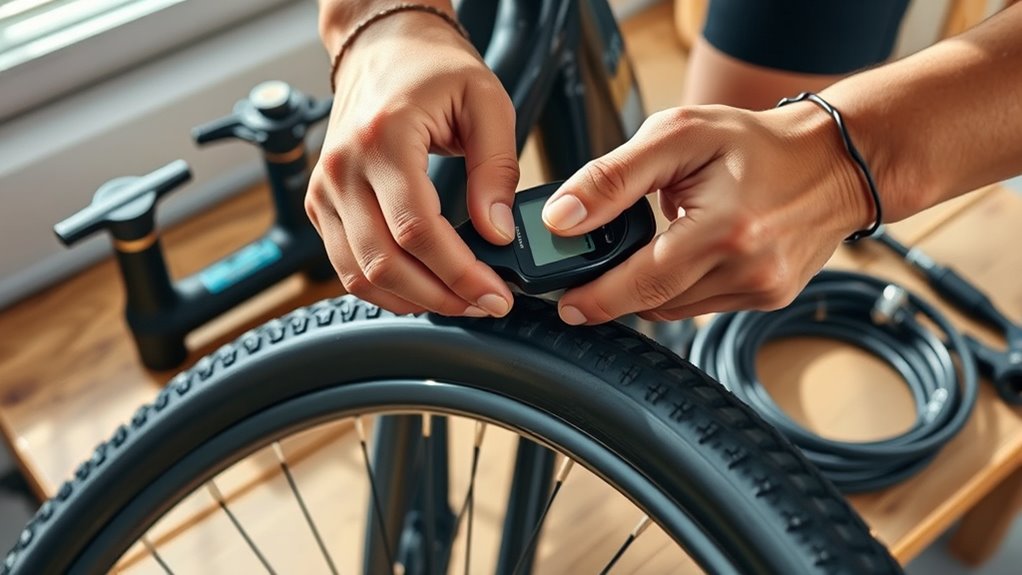
Checking and adjusting your tire pressure regularly is essential for ideal bike performance. Proper tire pressure improves ride comfort, handling, and reduces the risk of punctures or blowouts. To do this effectively:
- Use a reliable pressure gauge to check your tire pressure before each ride, aiming for the PSI indicated on the tire sidewall.
- Inflate your tires with a high-quality pump equipped with a pressure gauge to ensure accuracy.
- Adjust the pressure as needed—avoid under-inflating, which causes more wear, or over-inflating, which leads to a harsh ride and reduced traction.
- Monitoring your tire pressure regularly helps prevent premature tire wear and keeps your bike running smoothly. Incorporating knowledge about sound vibrations can also help you detect subtle changes in tire performance.
- Being aware of performance tuning principles can help you understand how proper tire pressure impacts overall bike handling and efficiency. Staying informed about tire maintenance practices can further extend the lifespan of your tires.
Maintaining correct tire pressure keeps your bike running smoothly and extends your tires’ lifespan. Regular checks help you stay safe and maximize performance every ride.
Inspect Bolts, Quick-Release Levers, and Hardware
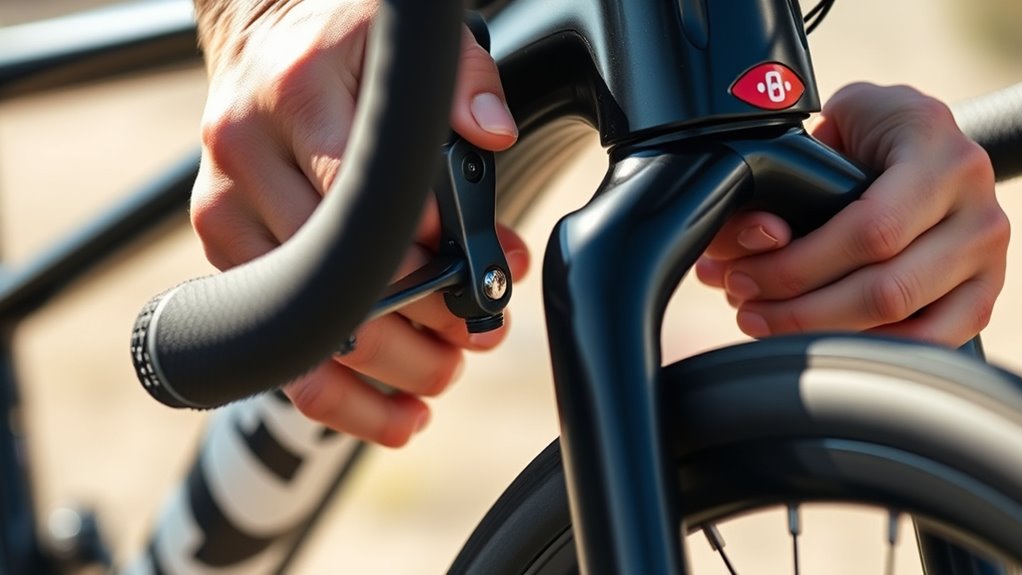
You should regularly check that all bolts, quick-release levers, and hardware are secure and tight. Make sure quick-release skewers are properly engaged, and look for any signs of wear or corrosion. Using a torque wrench periodically helps make certain everything stays tightened to safe levels. Additionally, inspecting bike components can help extend the lifespan of your bike components. Regular inspection and proper component care are essential for maintaining optimal bike performance. Staying aware of home cinema advancements can also inform you about the best tools and accessories to protect your bike.
Tighten Loose Components
Ensuring all bolts, quick-release levers, and hardware are properly tightened is essential for safe and smooth riding. If you notice any movement or rattling, address it immediately. To keep your bike in top shape, follow these steps:
- Check all bolts, nuts, and quick-release levers before each ride, tightening them to the manufacturer’s recommended torque.
- Use a torque wrench on critical components like stem bolts, seat post clamps, and brake screws to avoid over-tightening or loosening.
- Pay special attention to the headset, bottom bracket, and derailleur mounting bolts, as loose hardware here can impair handling and shifting.
- Regularly inspecting and tightening hardware can help prevent issues caused by loose components, which may otherwise lead to safety hazards or damage.
Check Quick-Release Security
Since quick-release mechanisms are critical for wheel security, it’s essential to verify they’re fully engaged before each ride. Check that all quick-release levers are closed tightly and securely lock the wheel in place. Ensure the quick-release bolts are tightened to the manufacturer’s recommended torque, usually around 3–5 Nm. Gently rock the wheel side to side to detect any play or looseness in the quick-release system. Inspect the levers for signs of damage, rust, or deformation that could compromise their locking ability. Confirm the skewer is centered and firmly clamped, with enough tension to hold the wheel securely without excessive force. Regularly check for defects or damage to maintain safety and prevent accidents. Proper tuning of the quick-release system is essential to ensure consistent performance and safety during rides. Additionally, regularly lubricate the mechanisms to prevent corrosion and ensure smooth operation. Keeping the quick-release skewer clean and free of debris can help maintain its proper function and longevity. Taking these steps helps maintain your bike’s quick-release security, ensuring your wheel stays in place during your ride.
Inspect Hardware Wear
Regularly inspecting hardware wear is essential to maintain your bike’s safety and performance. You should check all bolts, nuts, and quick-release levers to ensure they’re properly tightened to the manufacturer’s torque specifications. Focus on critical areas such as stem bolts, seatpost clamps, brake calipers, and wheel axles. A well-maintained bike also benefits from understanding the horsepower of your electric dirt bike to ensure optimal performance during rides. Here’s what you need to do:
- Look for signs of wear, corrosion, or damage on hardware components, replacing rusted or stripped fasteners immediately.
- Use a torque wrench for precise tightening, especially on carbon parts or components with specific torque requirements.
- Tighten any loose hardware to prevent failures during your ride.
- Regular inspections help identify filtration systems issues that could compromise component integrity and safety.
- Being aware of eye patch benefits can help you understand how protective gear might be used to enhance comfort during extended rides or recovery periods.
Lubricate Moving Parts and Chain
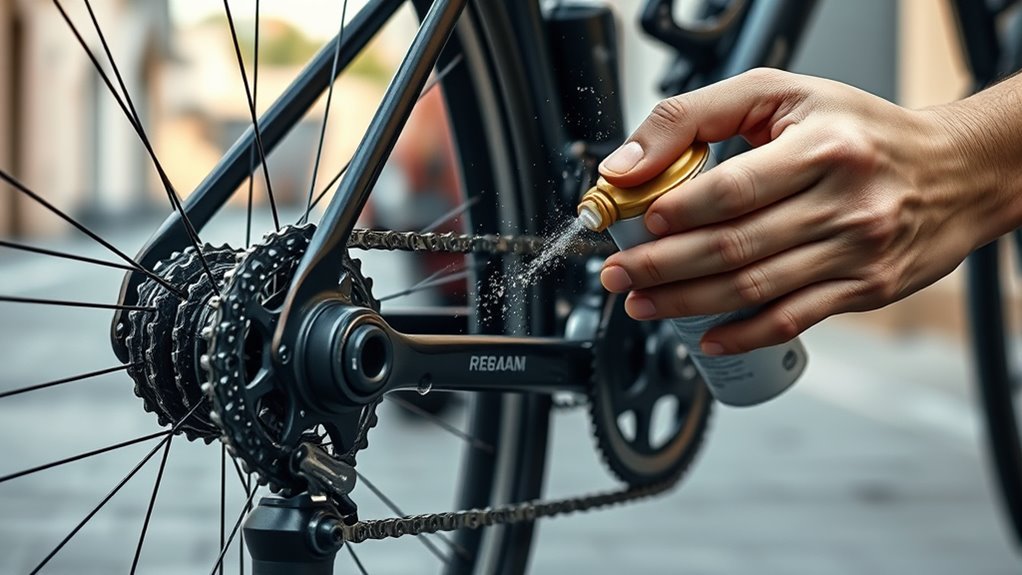
To keep your bike running smoothly, you need to choose the right lubricant for your riding conditions and apply it correctly. Make sure to use just enough to coat the chain and moving parts evenly, then wipe off any excess to avoid dirt buildup. Regular cleaning and re-lubing will help prevent rust, reduce wear, and keep your bike performing at its best. Proper lubrication is also essential for maintaining your bike’s long-term resilience, ensuring it remains reliable through various riding conditions. Additionally, using the appropriate maintenance routines can extend the life of your bike and improve overall safety. Utilizing high-quality lubricants designed specifically for bicycles can further enhance the effectiveness of your bike care routine.
Selecting Proper Lubricant
Choosing the right lubricant for your bike’s moving parts and chain is essential for smooth performance and durability. Selecting the appropriate chain lube depends on your riding conditions; for example, use Squirt or Muc-off Dry for dry environments, and Zefal Pro Wet for wet conditions.
To guarantee ideal lubrication:
- Apply a small amount of chain lube directly to the lower pulley of the derailleur and the chain links.
- Lubricate the chain after cleaning and drying, when the bike is dry.
- Wipe off any excess lubricant with a clean cloth to prevent dirt buildup.
Using the correct lube and applying it properly keeps your bike running smoothly and prolongs the lifespan of your chain and drivetrain components.
Applying Correct Amount
Applying the correct amount of lubricant is essential for effective bike maintenance; using too much can attract dirt and cause wear, while too little may leave parts unprotected. You should apply chain lubricant sparingly—just a few drops on each link—and focus on pivot points, derailleurs, and brake calipers. Use a lubricant suited to your riding conditions, then wipe off excess to prevent dirt buildup. Regularly perform routine checks and reapply lubricant on high-friction components to ensure smooth operation and prolong component lifespan. Keep in mind the maintenance schedule: lubricate every 100-200 miles or after riding in wet conditions. Proper application avoids over-lubrication and keeps your bike running smoothly.
| Part to Lubricate | Amount to Apply |
|---|---|
| Chain | Few drops per link |
| Pivot points | Small, controlled amount |
| Derailleurs | Light coating |
| Brake calipers | Minimal to avoid slippage |
Regular Cleaning and Re-lubing
Regular cleaning and re-lubing are essential for keeping your bike’s moving parts functioning smoothly. After each ride, especially in wet or muddy conditions, you should focus on your bike chain. Here’s what to do:
- Clean the bike chain thoroughly with a degreaser to remove dirt and grime.
- Apply a suitable lubricant—wet, dry, or all-weather—while turning the pedals backward for even coverage.
- Wipe off any excess lubricant with a clean rag to prevent dirt buildup and ensure smooth operation.
Regular cleaning and re-lubrication of your bike chain and other moving parts, like derailleur pivots and cables, prevent corrosion and keep your bike responsive. Use high-quality lubricants and re-lubricate every 200-500 miles for peak performance.
Secure and Store Your Bike Properly
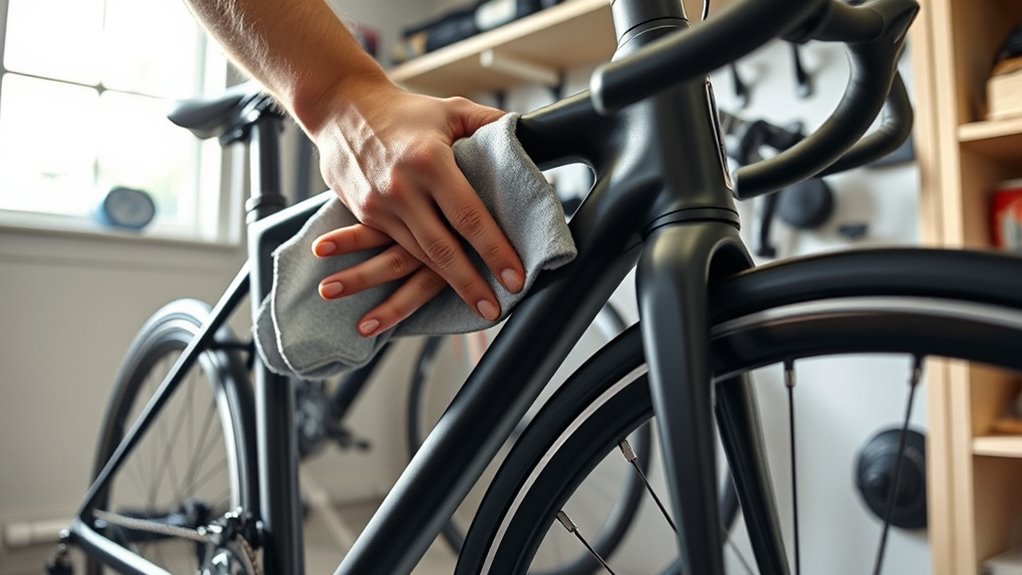
To keep your bike in top shape, it’s essential to store it properly when you’re not riding. Choose a dry, climate-controlled environment to prevent rust, corrosion, and damage caused by moisture or extreme temperatures. Store your bike upright or on a wall rack to avoid unnecessary stress on components and prevent accidental falls or scratches. If outdoor storage is unavoidable, use a high-quality bike cover to shield it from rain, UV rays, dirt, and debris that can accelerate wear. Always lock your bike securely with strong locks, and keep it in a well-lit area to deter theft and vandalism. Regularly check the storage environment for pests, moisture, or hazards that could compromise your bike’s condition over time. Proper storage extends your bike’s longevity.
Examine for Damage or Wear and Tear
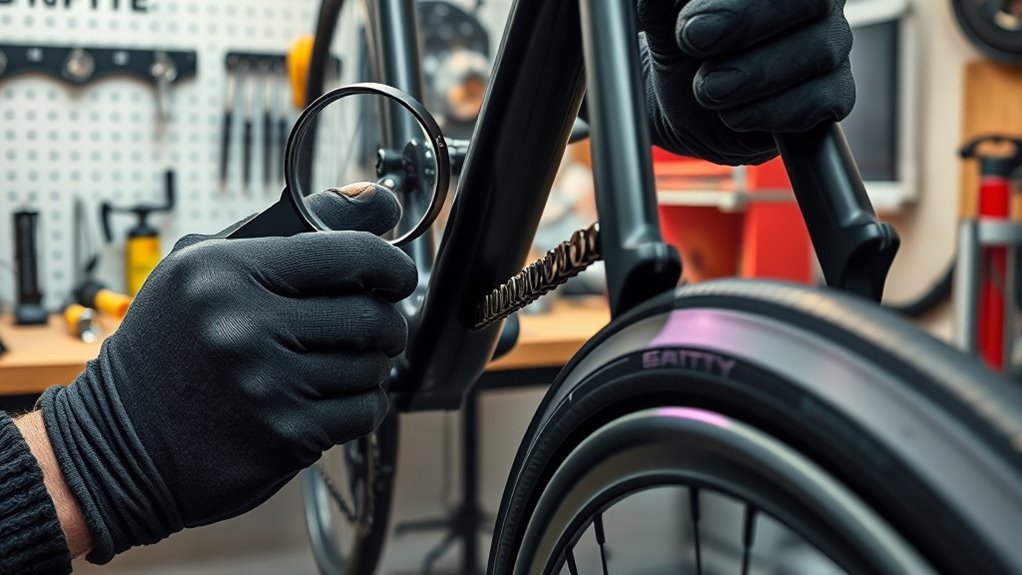
Inspecting your bike regularly for damage and wear is crucial to guarantee safe and smooth rides. First, check your brake pads for thinning below 3mm or smooth grooves, which indicate they need replacing. Second, look for damage on the brake cables, such as fraying, rust, or any signs of deterioration that could affect braking performance. Third, examine the frame and components for visible cracks, dents, or deformation, especially after impacts. Additionally, run your thumbs over tires to detect minor punctures or dry rot, and spin the wheels to identify wobbles or uneven rotation that may require truing. Addressing issues early ensures your brake pads function properly, prevents damage, and maintains your bike’s longevity.
Recharge Electronic Components and Lights
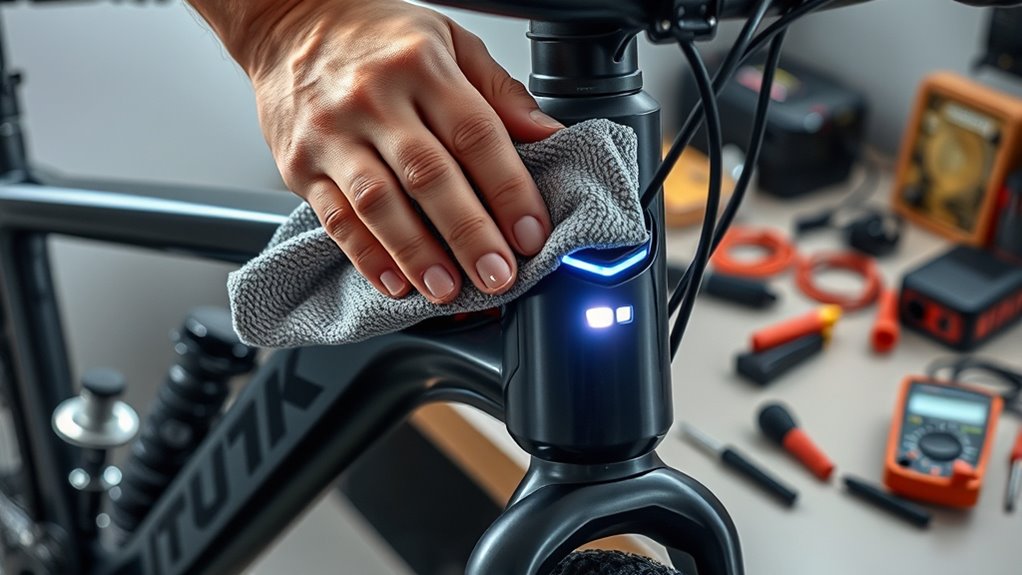
After checking your bike for damage and wear, it’s important to guarantee all electronic components and lights are fully powered for your next ride. To do this, recharge your lights and electronic shifters promptly after each use. Use the designated charging cable and follow the manufacturer’s instructions to prevent overcharging or damaging the batteries. Check the battery level indicator before and after charging to ensure a complete recharge. Store rechargeable batteries in a cool, dry place to maximize their lifespan and avoid capacity loss. Regularly inspect charging ports and cables for damage or corrosion, as this ensures reliable recharging when needed. Keeping your electronic components and lights properly recharged guarantees top-notch performance and safety during every ride.
Perform a Quick Safety Check Before Your Next Ride
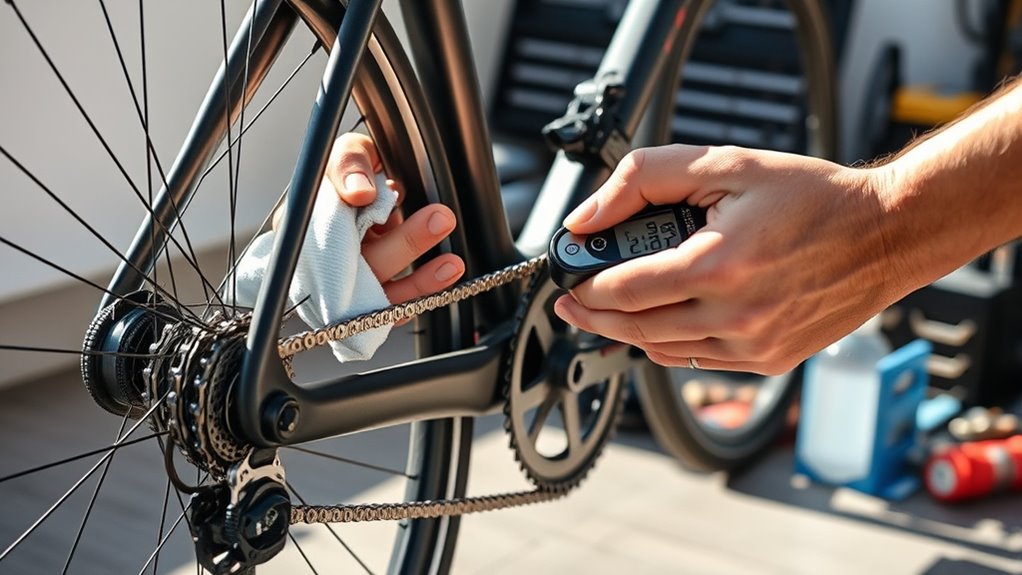
Before heading out, it’s essential to perform a quick safety check to guarantee your bike is ready for the ride. First, check the tire pressure to verify it matches the recommended PSI printed on the sidewall for maximal safety and performance. Next, inspect your brakes and brake pads visually to confirm they’re functioning properly and aren’t overly worn. Spin the wheels to verify they rotate smoothly without wobbling or rubbing against brake pads or the frame. Finally, tighten any loose bolts or quick-release levers, especially on the handlebars, seat post, and wheels, to prevent accidents. This quick routine ensures your bike is safe, reliable, and ready for your ride, helping you avoid issues and enjoy a smooth cycling experience.
Frequently Asked Questions
What Regular Maintenance Should Be Done on a Bicycle?
To keep your bike in top shape, you should check tire pressure before each ride, ensuring it matches the recommended PSI. Tighten bolts, screws, and quick-release levers regularly to stay safe. Inspect brake and gear cables for fraying or slack, lubricate or replace as needed. Clean and lubricate the chain frequently, and do a quick overall safety check, including wheel spin and brake response, to catch issues early.
What Is the Average Lifespan of a Bicycle?
Did you know a well-maintained bicycle can last between 5 to 10 years? Your bike’s lifespan depends on how often you ride, the conditions you ride in, and your maintenance routine. If you keep up with regular care, like cleaning and checking components, your bike could even serve you beyond a decade. Proper storage and timely replacements can stretch your bike’s life to 10,000 or more miles.
What Happens to Your Body When You Ride a Bike Everyday?
When you ride a bike every day, your body benefits in many ways. You boost your cardiovascular health, making your heart more efficient and lowering disease risk. Your leg muscles, including quadriceps, hamstrings, and calves, grow stronger, improving endurance. Cycling also releases endorphins, lifting your mood and reducing anxiety. Plus, you burn calories, aiding weight loss, and enhance joint flexibility, keeping hips, knees, and ankles healthy through low-impact movement.
What Is a Good Distance to Cycle Everyday?
A good distance to cycle every day balances fitness, enjoyment, and bike care. You should aim for about 10 to 20 miles, which helps maintain your health without overloading your bike. Cycling this range prevents excessive wear, reduces the need for repairs, and keeps your rides enjoyable. Adjust based on your fitness level, terrain, and bike type, but sticking to this range provides a sustainable, healthy routine.
Conclusion
By sticking to this routine, you’ll keep your bike humming like a well-oiled engine, ready to hit the road anytime. Think of your bike as a trusted companion, thriving on your care and attention. Regular maintenance is the gentle rain that keeps it shining and strong, turning every ride into a smooth, joyful adventure. With a little love each day, your bike will serve you faithfully for years to come.


